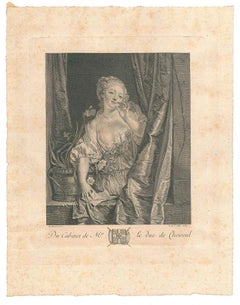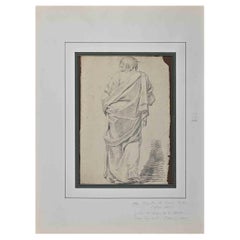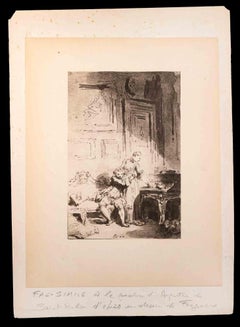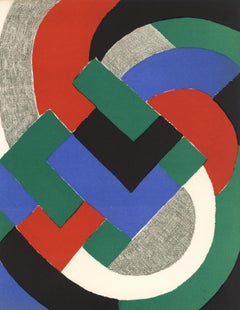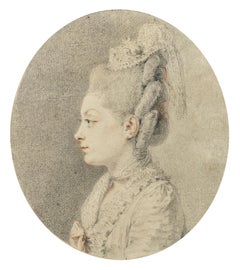Augustin de Saint-Aubin Art
French, 1736-1807
Augustin de Saint-Aubin was born on January 3rd 1736 into a family of artists: his father Gabriel-Germain (1696-1756) was the King's embroiderer and his six surviving siblings (Charles-Germain (born in 1721), Gabriel-Jacques (1724), Catherine-Louise (1727), Louis-Michel (1731), Athanase (1734) and Agathe (1739)) were also artists. The eldest of the boys, Charles-Germain, became a draughtsman and embroiderer like his father, Gabriel-Jacques? is considered one of the most brilliant draughtsmen of the 18th century, Louis-Michel became a painter at the Sèvres porcelain manufactory and Athanase an actor, while his two sisters were also talented draughtswomen.
During his lifetime Augustin de Saint-Aubin's fame as a draughtsman and engraver far out-shadowed that of his twelve-year-old elder brother Gabriel, but the Goncourt brothers initiated research into the French 18th century art sphere which gave back its pre-eminence to Gabriel’s works.
Initially trained by his brother Gabriel, the young Augustin continued his apprenticeship with the engraver Etienne Fessard (1714 - 1777) and very quickly set his sights on becoming an engraver.
Accepted to the Académie Royale in 1771, he was never admitted because he did not submit his reception piece. This did not prevent him from having a successful and very prolific career as an engraver, since his output is estimated at more than 1,300 engravings.
Portraits - whether drawn or engraved - constitute the best part of his work and also the most sought-after, particularly by the Goncourt brothers, who owned several portraits among the dozen or so drawings of Augustin de Saint-Aubin they had collected/in their collection.to
3
Overall Width
to
Overall Height
to
2
1
2
3
3
3
2
2
1
1
1
1
1
1
3
7,820
5,167
2,504
1,501
1
Artist: Augustin de Saint-Aubin
La Baiser Envoye - Etching by Augustin de Saint-Aubin -Mid 18th century
By Augustin de Saint-Aubin
Located in Roma, IT
La Baiser Envoye is a splendid etching realized around the mid-XVIII century in France by the engraver Augustin de Saint-Aubin (Paris, 1736 – 1807), belonging to an important dynasty...
Category
18th Century Modern Augustin de Saint-Aubin Art
Materials
Etching
Figure of Man - Original Pencil Drawing by Augustin de Saint-Aubin- 19th Century
By Augustin de Saint-Aubin
Located in Roma, IT
Figure of Man is an Original Pencil Drawing realized by Augustin de Saint-Aubin (1736-1807).
Good condition included a green and white cardboard passpartout (65x48 cm).
No signatur...
Category
Late 18th Century Modern Augustin de Saint-Aubin Art
Materials
Pencil
Young Lovers - Original Lithograph by Augustin de Saint-Aubin- 19th Century
By Augustin de Saint-Aubin
Located in Roma, IT
Young Lovers is an original artwork, lithograph, "d'après" after an etching of Augustin de Saint-Aubin after a Fragonard's drawing. Is not signed and dated...
Category
19th Century Modern Augustin de Saint-Aubin Art
Materials
Lithograph
Related Items
French Modern Drawing by Jean Hélion - Veil Homme
By Jean Hélion
Located in Paris, IDF
Veil Homme
1947
drawing
26,9 x 21 x 0,1 cm
Registered on the catalogue raisonné with inventory number : N°0252 cat. B
sold without frame
about Jean Hélion (April 21, 1904 – October ...
Category
1960s Modern Augustin de Saint-Aubin Art
Materials
Paper, Pencil
Delaunay, Composition, XXe Siècle (after)
By Sonia Delaunay
Located in Auburn Hills, MI
Lithograph on vélin paper. Unsigned and unnumbered, as issued. Good condition. Notes: From the volume, XXe Siècle, vol. n°32, 1969. Published and printed under the direction of Gualt...
Category
1960s Modern Augustin de Saint-Aubin Art
Materials
Lithograph
'Cargo Carriers' — New York Harbor
By Otto Kuhler
Located in Myrtle Beach, SC
Otto Kuhler, 'Cargo Carriers', etching and drypoint, c. 1932, edition 10, Kennedy 44. Signed in pencil. A superb, atmospheric impression with rich burr and selectively wiped overall plate tone, in dark brown ink, on Arches cream laid paper; wide margins (2 to 2 3/4 inches), in very good condition. Printed by the artist. Original Kennedy Galleries mat and label. Scarce.
"On my trips up and down N.Y. harbor on the Weehawken Ferry, the late evening sun playing on the side of the big liners has always intrigued me... The liner shown I believe to be the Vaterland of the North German Lloyd...
Category
1930s American Modern Augustin de Saint-Aubin Art
Materials
Etching, Drypoint
Landscape
By Robert Kipniss
Located in San Francisco, CA
This artwork "Landscape" c.1980 is an original color lithograph on wove paper by noted American artist Robert Kipniss, b.1931. It is hand signed and numbered 168/200 in pencil by the...
Category
Late 20th Century American Modern Augustin de Saint-Aubin Art
Materials
Lithograph
1940s Charcoal and Pencil Portrait of a Man
Located in Arp, TX
Artist Unknown
"Tie and Glasses"
c. 1940s
Charcoal and pencil on paper
13.5"x17" site 19"x23" rustic wood frame
Unsigned
Category
1940s Modern Augustin de Saint-Aubin Art
Materials
Paper, Charcoal, Carbon Pencil
Matisse, Série P, var. 1 (Duthuit 9), Dessins, Thèmes et variations (after)
By Henri Matisse
Located in Auburn Hills, MI
Lithograph on vélin pur fil paper. Inscription: Signed in the plate and unnumbered, as issued. Good condition. Notes: From the folio, Henri Matisse, Dessins, Thèmes et Variations, 19...
Category
1940s Modern Augustin de Saint-Aubin Art
Materials
Lithograph
H 12.875 in W 9.625 in
“Chorus Boys”
By Nahum Tschacbasov
Located in Southampton, NY
Black and white original artist proof etching by the well known Russian/American artist Nahum Tschacbasov. Marked “Artist Proof lower left in pencil. Signed by the artist lower righ...
Category
1930s Modern Augustin de Saint-Aubin Art
Materials
Archival Paper, Etching
Mexican Street Scene
By Miguel Covarrubias
Located in New York, NY
A very good impression of this lithograph, from an edition of 250. Signed in pencil by Covarrubias. Published by Associated American Artists, New York.
Category
1940s Modern Augustin de Saint-Aubin Art
Materials
Lithograph
The Biggest of All; Telephone and Telegraph Building.
By Joseph Pennell
Located in Storrs, CT
The Biggest of All; Telephone and Telegraph Building. 1925. Etching. Wuerth 853. 9 7/8 x 11 7/8 (sheet 11 1/2 x 17 1/8). Edition probably 35. An atmospheric impression with plate tone, printed on antique laid paper...
Category
Early 20th Century American Modern Augustin de Saint-Aubin Art
Materials
Drypoint, Etching
H 9.88 in W 7.88 in D 0.5 in
"Contemplation"
By Gershon Benjamin
Located in Lambertville, NJ
Jim’s of Lambertville is proud to offer this artwork by:
Gershon Benjamin (1899-1985)
An American Modernist of portraits, landscapes, still lives, and the urban scene, Gershon Benj...
Category
1920s Modern Augustin de Saint-Aubin Art
Materials
Graphite
Black Panther Trials - Civil Rights Movement Police Violence African American
Located in Miami, FL
The Black Panther Trials - In this historically significant work, African American Artist Vicent D. Smith functions as an Art Journalist/ Court Reporter as much as a
Artist. Here, he depicts, in complete unity, 21 Black Panther Protestors raising their fist of defiance at the White Judge. Smith's composition is about utter simplicity, where the Black Panther Protestors are symmetrically lined up in a confrontation with a Judge whose size is exaggerated in scale. Set against a stylized American Flag, the supercilious Judge gazes down as the protesters as their fists thrust up. Signed Vincent lower right. Titled Panter 21. Original metal frame. Tape on upper left edge of frame. 255 . Panther 21. Framed under plexi.
_____________________________
From Wikipedia
In 1969-1971 there was a series of criminal prosecutions in New Haven, Connecticut, against various members and associates of the Black Panther Party.[1] The charges ranged from criminal conspiracy to first-degree murder. All charges stemmed from the murder of 19-year-old Alex Rackley in the early hours of May 21, 1969. The trials became a rallying-point for the American Left, and marked a decline in public support, even among the black community, for the Black Panther Party
On May 17, 1969, members of the Black Panther Party kidnapped fellow Panther Alex Rackley, who had fallen under suspicion of informing for the FBI. He was held captive at the New Haven Panther headquarters on Orchard Street, where he was tortured and interrogated until he confessed. His interrogation was tape recorded by the Panthers.[2] During that time, national party chairman Bobby Seale visited New Haven and spoke on the campus of Yale University for the Yale Black Ensemble Theater Company.[3] The prosecution alleged, but Seale denied, that after his speech, Seale briefly stopped by the headquarters where Rackley was being held captive and ordered that Rackley be executed. Early in the morning of May 21, three Panthers – Warren Kimbro, Lonnie McLucas, and George Sams, one of the Panthers who had come East from California to investigate the police infiltration of the New York Panther chapter, drove Rackley to the nearby town of Middlefield, Connecticut. Kimbro shot Rackley once in the head and McLucas shot him once in the chest. They dumped his corpse in a swamp, where it was discovered the next day. New Haven police immediately arrested eight New Haven area Black Panthers. Sams and two other Panthers from California were captured later.
Sams and Kimbro confessed to the murder, and agreed to testify against McLucas in exchange for a reduction in sentence. Sams also implicated Seale in the killing, telling his interrogators that while visiting the Panther headquarters on the night of his speech, Seale had directly ordered him to murder Rackley. In all, nine defendants were indicted on charges related to the case. In the heated political rhetoric of the day, these defendants were referred to as the "New Haven Nine", a deliberate allusion to other cause-celebre defendants like the "Chicago Seven".
The first trial was that of Lonnie McLucas, the only person who physically took part in the killing who refused to plead guilty. In fact, McLucas had confessed to shooting Rackley, but nonetheless chose to go to trial.
Jury selection began in May 1970. The case and trial were already a national cause célèbre among critics of the Nixon administration, and especially among those hostile to the actions of the FBI. Under the Bureau's then-secret "Counter-Intelligence Program" (COINTELPRO), FBI director J. Edgar Hoover had ordered his agents to disrupt, discredit, or otherwise neutralize radical groups like the Panthers. Hostility between groups organizing political dissent and the Bureau was, by the time of the trials, at a fever pitch. Hostility from the left was also directed at the two Panthers cooperating with the prosecutors. Sams in particular was accused of being an informant, and lying to implicate Seale for personal benefit.
In the days leading up to a rally on May Day 1970, thousands of supporters of the Panthers arrived in New Haven individually and in organized groups. They were housed and fed by community organizations and by sympathetic Yale students in their dormitory rooms. The Yale college dining halls provided basic meals for everyone. Protesters met daily en masse on the New Haven Green across the street from the Courthouse (and one hundred yards from Yale's main gate). On May Day there was a rally on the Green, featuring speakers including Jean Genet, Abbie Hoffman, Jerry Rubin, and John Froines (an assistant professor of chemistry at the University of Oregon). Teach-ins and other events were also held in the colleges themselves.
Towards midnight on May 1, two bombs exploded in Yale's Ingalls Rink, where a concert was being held in conjunction with the protests.[4] Although the rink was damaged, no one was injured, and no culprit was identified.[4]
Yale chaplain William Sloane Coffin stated, "All of us conspired to bring on this tragedy by law enforcement agencies by their illegal acts against the Panthers, and the rest of us by our immoral silence in front of these acts," while Yale President Kingman Brewster Jr. issued the statement, "I personally want to say that I'm appalled and ashamed that things should have come to such a pass that I am skeptical of the ability of a Black revolutionary to receive a fair trial anywhere in the U.S." Brewster's generally sympathetic tone enraged many of the university's older, more conservative alumni, heightening tensions within the school community.
As tensions mounted, Yale officials sought to avoid deeper unrest and to deflect the real possibility of riots or violent student demonstrations. Sam Chauncey has been credited with winning tactical management on behalf of the administration to quell anxiety among law enforcement and New Haven's citizens, while Kurt Schmoke, a future Rhodes Scholar, mayor of Baltimore, MD and Dean of Howard University School of Law, has received kudos as undergraduate spokesman to the faculty during some of the protest's tensest moments. Ralph Dawson, a classmate of Schmoke's, figured prominently as moderator of the Black Student Alliance at Yale (BSAY).
In the end, compromises between the administration and the students - and, primarily, urgent calls for nonviolence from Bobby Seale and the Black Panthers themselves - quashed the possibility of violence. While Yale (and many other colleges) went "on strike" from May Day until the end of the term, like most schools it was not actually "shut down". Classes were made "voluntarily optional" for the time and students were graded "Pass/Fail" for the work done up to then.
Trial of McLucas
Black Panther trial sketch...
Category
1970s American Modern Augustin de Saint-Aubin Art
Materials
Watercolor, Pen, Pencil, Paper
Les Petit Rats, Ballerinas V
By Graciela Rodo Boulanger
Located in San Francisco, CA
This artwork titled "Les Petit Rats, Ballerinas V" c.1980 is an original color lithograph on Japan paper by noted Bolivian artist Graciela Rodo Boulanger, b.1935. It is hand signed and numbered XLII/C in pencil by the artist. The image size is 22.5 x 18 inches, framed size is 36 x 30.75 inches. Custom framed in a wooden gold leaf frame, with off white matting and gold color spacer. It is in excellent condition.
About the artist:
Born in La Paz, Bolivia in 1935, Graciela Rodo Boulanger was raised in an artistic environment. Her mother, a concert pianist, and her father, a businessman and art connoisseur, nurtured her talents. She studied the piano and at age 11 enrolled in the School of Fine Arts. At 17 she went to Vienna to study both art and music, and at 22 shetravelled to Argentina for the stimulating artistic environment of Buenos Aires. Continuing to study both piano and painting...
Category
Late 20th Century Modern Augustin de Saint-Aubin Art
Materials
Lithograph
Previously Available Items
Portrait of a Lady, Drawing Signed and Dated by Augustin de Saint-Aubin
By Augustin de Saint-Aubin
Located in PARIS, FR
This drawing full of freshness presents us with the profile of an elegant lady, drawn by Augustin de Saint-Aubin on a beautiful summer day in 1776, during the early months of Louis X...
Category
1770s Old Masters Augustin de Saint-Aubin Art
Materials
Pastel, Pencil
Augustin De Saint-aubin art for sale on 1stDibs.
Find a wide variety of authentic Augustin de Saint-Aubin art available for sale on 1stDibs. You can also browse by medium to find art by Augustin de Saint-Aubin in pencil, crayon, pastel and more. Much of the original work by this artist or collective was created during the 18th century and is mostly associated with the Old Masters style. Not every interior allows for large Augustin de Saint-Aubin art, so small editions measuring 5 inches across are available. Customers who are interested in this artist might also find the work of George Romney, Maurice Chabas, and Daniel Ginsbourg. Augustin de Saint-Aubin art prices can differ depending upon medium, time period and other attributes. On 1stDibs, the price for these items starts at $88 and tops out at $4,500, while the average work can sell for $2,150.
